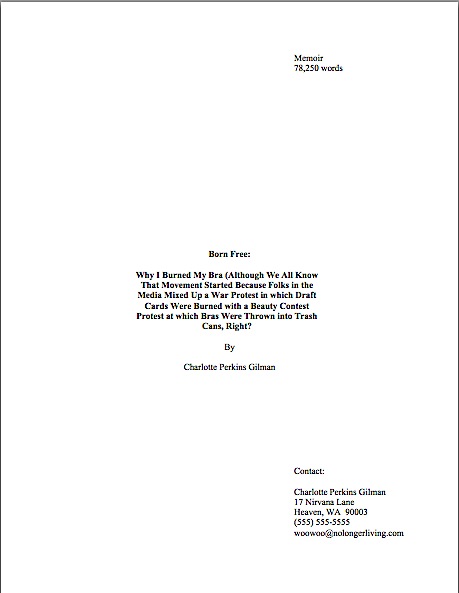

- Slugline title page how to#
- Slugline title page software#
- Slugline title page free#
I made sure that I was writing in the correct font size (12pt) and the correct font (Courier new). I did this by evaluating a script in LO1 and ensuring that I structured the script in the same way and lay it out in the same way. I made sure that I followed all of the conventions of a film script. Since Google Docs doesn’t allow you to create a capitalized style, you’ll have to remember to always write them in all-caps when they appear in your screenplay.įollow the screenplay formatting requirements listed above to ensure your screenplay has the appropriate white space, line spacing, indentation, and styles.Below are screenshots of my horror/thriller script, which is a short film. Slugline, Character, and transition always appear in all caps in a screenplay. You may choose to capitalize or bold the slugline, depending on what best suits your screenplay. Transition: Emphasizes changing to a new sceneĮach word uses a distinct font in the screenplay you’re writing, and you will format them each differently.Slugline: Tells the time and place of each scene, also called scene header.
Slugline title page how to#
Parenthetical: Brackets before the dialogue that explain how to deliver the line. Dialogue: What the characters in your screenplay are saying. Character: Tells you which character is talking, comes before the dialogue line. Action: Describes what is happening in the scene, describes characters and setting. Next, write the following words on their separate lines: You may also use other Courier versions, such as Courier Prime or Courier New. Maybe for some, that opinion is preferred.Īs we mentioned earlier, the standard font for screenplays is a 12-point Courier Font. With WritersRoom, you click on each element you want to add to your screenplay, and that can be a bit time-consuming. This is also a good addon but works a bit differently. There is an alternative called WritersRoom. But those can be easily fixed, so it isn’t a real issue. The only issue we had with the Fountainize is that it can be a bit buggy sometimes. Then I just press the ‘Format Script’ button.Īnd there you have it! It doesn’t get much easier than that. Let us look at an example of a screenplay I want to format in Google Docs: Centered: Text that starts with > and ends with <. Action: Text not formatted in a particular way. 
Transition: A line that ends with “in:”, “to:”, or “out:” For example CUT TO:.Paranthetical: A line immedietly following a character or dialogue with brackets ().
 Dialouge: A line immedietly following a character. Characters: Fountainize dectes characters in all capital letters and with no punctuation at the end. Scene: A scene has to start with the INT. The idea here is to write the text for your screenplay first and then press ‘Format Script’ on the sidebar.įor this to work, though, you have to know the basic rules for formatting. When you add Fountainize to a document, a sidebar will appear with formatting options for your script. The easiest option is to click on ‘Show sidebar.’ Once installed, you can access Fountainize through the add-ons toolbar. With the Fountainize addon, you can work on solo or collaborative scripts to format your screenplay in Google Docs.
Dialouge: A line immedietly following a character. Characters: Fountainize dectes characters in all capital letters and with no punctuation at the end. Scene: A scene has to start with the INT. The idea here is to write the text for your screenplay first and then press ‘Format Script’ on the sidebar.įor this to work, though, you have to know the basic rules for formatting. When you add Fountainize to a document, a sidebar will appear with formatting options for your script. The easiest option is to click on ‘Show sidebar.’ Once installed, you can access Fountainize through the add-ons toolbar. With the Fountainize addon, you can work on solo or collaborative scripts to format your screenplay in Google Docs. Slugline title page free#
The easiest way to format your screenplay in Google Docs is using the free Fountainize add-on. Google Docs has all of the fonts and tools you need to format your script effectively.įormat Your Screenplay in Google Docs (The Easy Way)
Slugline title page software#
Page numbers begin on the second page of the screenplay (the third sheet of paper including the title page), which is numbered 2Īs you can see, formatting a screenplay doesn’t require software with complex algorithms. Don’t number the title page, and don’t count it as page one. Dialogue box begins 2.5 inches from the left side of the page (1.5 inches from margin). Capitalize transitions (sometimes necessary props, sounds, and camera movements). Dialogue speaker names (in all caps) 3.7 inches from the left side of the page (2.2 from the margin). Actor parenthetical (wrylies) 3.1 inches from the left side of the page (1.6 from the margin). Each page has about 55 lines, whatever the paper size, excluding the page number and spaces after it. 1-inch right margin (between 0.5 inches and 1.25 inches), ragged. However, if you’re targeting a specific studio, consider using one of their past screenplays as a formatting guide.Īccording to the Nashville Film Institute, the following is the standard screenplay format: Generally, there’s a slight variation between screenplays when it comes to spacing, fonts, and indentations. Before you begin formatting your screenplay in Google Docs, it’s important to know what formatting studios look for in screenplays they’re reviewing.







 0 kommentar(er)
0 kommentar(er)
